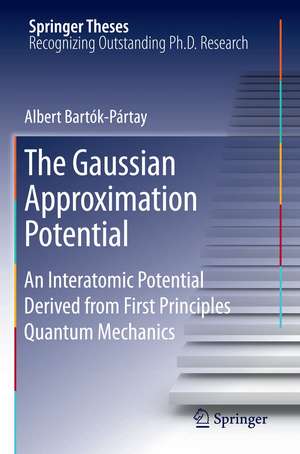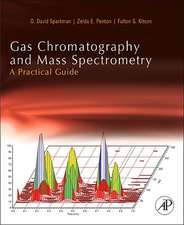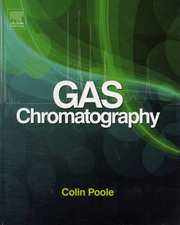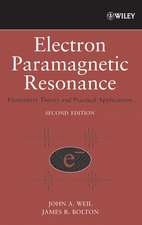The Gaussian Approximation Potential: An Interatomic Potential Derived from First Principles Quantum Mechanics: Springer Theses
Autor Albert Bartók-Pártayen Limba Engleză Paperback – 13 oct 2012
| Toate formatele și edițiile | Preț | Express |
|---|---|---|
| Paperback (1) | 717.72 lei 6-8 săpt. | |
| Springer Berlin, Heidelberg – 13 oct 2012 | 717.72 lei 6-8 săpt. | |
| Hardback (1) | 721.63 lei 6-8 săpt. | |
| Springer Berlin, Heidelberg – 6 aug 2010 | 721.63 lei 6-8 săpt. |
Din seria Springer Theses
- 18%
 Preț: 997.88 lei
Preț: 997.88 lei -
 Preț: 389.88 lei
Preț: 389.88 lei - 15%
 Preț: 646.94 lei
Preț: 646.94 lei - 18%
 Preț: 943.43 lei
Preț: 943.43 lei -
 Preț: 399.29 lei
Preț: 399.29 lei - 18%
 Preț: 944.99 lei
Preț: 944.99 lei - 15%
 Preț: 636.80 lei
Preț: 636.80 lei - 18%
 Preț: 941.05 lei
Preț: 941.05 lei - 15%
 Preț: 643.16 lei
Preț: 643.16 lei - 15%
 Preț: 642.68 lei
Preț: 642.68 lei - 18%
 Preț: 1103.62 lei
Preț: 1103.62 lei - 20%
 Preț: 558.83 lei
Preț: 558.83 lei - 18%
 Preț: 1112.30 lei
Preț: 1112.30 lei - 18%
 Preț: 944.19 lei
Preț: 944.19 lei - 18%
 Preț: 1109.92 lei
Preț: 1109.92 lei - 18%
 Preț: 1217.27 lei
Preț: 1217.27 lei - 15%
 Preț: 640.06 lei
Preț: 640.06 lei - 15%
 Preț: 636.45 lei
Preț: 636.45 lei - 15%
 Preț: 640.06 lei
Preț: 640.06 lei - 15%
 Preț: 640.88 lei
Preț: 640.88 lei -
 Preț: 389.70 lei
Preț: 389.70 lei - 20%
 Preț: 563.91 lei
Preț: 563.91 lei -
 Preț: 393.35 lei
Preț: 393.35 lei - 15%
 Preț: 637.93 lei
Preț: 637.93 lei - 15%
 Preț: 641.85 lei
Preț: 641.85 lei - 18%
 Preț: 1225.94 lei
Preț: 1225.94 lei - 20%
 Preț: 551.36 lei
Preț: 551.36 lei - 18%
 Preț: 1229.10 lei
Preț: 1229.10 lei - 15%
 Preț: 639.25 lei
Preț: 639.25 lei - 18%
 Preț: 999.45 lei
Preț: 999.45 lei - 15%
 Preț: 640.06 lei
Preț: 640.06 lei - 18%
 Preț: 1220.45 lei
Preț: 1220.45 lei - 18%
 Preț: 1116.26 lei
Preț: 1116.26 lei - 18%
 Preț: 1110.72 lei
Preț: 1110.72 lei - 18%
 Preț: 1000.87 lei
Preț: 1000.87 lei - 18%
 Preț: 891.17 lei
Preț: 891.17 lei - 15%
 Preț: 640.06 lei
Preț: 640.06 lei - 5%
 Preț: 1154.07 lei
Preț: 1154.07 lei - 15%
 Preț: 635.96 lei
Preț: 635.96 lei - 15%
 Preț: 640.88 lei
Preț: 640.88 lei -
 Preț: 387.20 lei
Preț: 387.20 lei - 18%
 Preț: 1109.92 lei
Preț: 1109.92 lei -
 Preț: 385.25 lei
Preț: 385.25 lei -
 Preț: 385.25 lei
Preț: 385.25 lei - 18%
 Preț: 1112.30 lei
Preț: 1112.30 lei - 18%
 Preț: 999.45 lei
Preț: 999.45 lei -
 Preț: 386.99 lei
Preț: 386.99 lei - 15%
 Preț: 637.13 lei
Preț: 637.13 lei - 20%
 Preț: 554.21 lei
Preț: 554.21 lei - 20%
 Preț: 555.59 lei
Preț: 555.59 lei
Preț: 717.72 lei
Preț vechi: 875.26 lei
-18% Nou
Puncte Express: 1077
Preț estimativ în valută:
137.35€ • 149.14$ • 115.38£
137.35€ • 149.14$ • 115.38£
Carte tipărită la comandă
Livrare economică 23 aprilie-07 mai
Preluare comenzi: 021 569.72.76
Specificații
ISBN-13: 9783642264269
ISBN-10: 3642264263
Pagini: 104
Ilustrații: XIV, 90 p. 31 illus., 2 illus. in color.
Dimensiuni: 155 x 235 x 5 mm
Greutate: 0.16 kg
Ediția:2010
Editura: Springer Berlin, Heidelberg
Colecția Springer
Seria Springer Theses
Locul publicării:Berlin, Heidelberg, Germany
ISBN-10: 3642264263
Pagini: 104
Ilustrații: XIV, 90 p. 31 illus., 2 illus. in color.
Dimensiuni: 155 x 235 x 5 mm
Greutate: 0.16 kg
Ediția:2010
Editura: Springer Berlin, Heidelberg
Colecția Springer
Seria Springer Theses
Locul publicării:Berlin, Heidelberg, Germany
Public țintă
ResearchCuprins
Representation of Atomic Environments.- Gaussian Process.- Interatomic Potentials.- Computational Methods.- Results.- Conclusion and Further Work.- Appendices.
Recenzii
From the reviews:
“This book is actually an account of the Ph.D. work of the author, and is aimed at practitioners of molecular simulation (physicists and materials scientists, mostly) who want to construct reliable empirical force fields parameterized by data obtained from equilibrium quantum mechanical computations.” (Gabriel Stoltz, Mathematical Reviews, Issue 2011 j)
“This book is actually an account of the Ph.D. work of the author, and is aimed at practitioners of molecular simulation (physicists and materials scientists, mostly) who want to construct reliable empirical force fields parameterized by data obtained from equilibrium quantum mechanical computations.” (Gabriel Stoltz, Mathematical Reviews, Issue 2011 j)
Textul de pe ultima copertă
Simulation of materials at the atomistic level is an important tool in studying microscopic structures and processes. The atomic interactions necessary for the simulations are correctly described by Quantum Mechanics, but the size of systems and the length of processes that can be modelled are still limited. The framework of Gaussian Approximation Potentials that is developed in this thesis allows us to generate interatomic potentials automatically, based on quantum mechanical data. The resulting potentials offer several orders of magnitude faster computations, while maintaining quantum mechanical accuracy. The method has already been successfully applied for semiconductors and metals.
Caracteristici
Describes an important advance in the generation of accurate interatomic potentials The method yields several orders of magnitude faster computations Nominated as an outstanding contribution by the Theory of Condensed Matter Group of Cambridge University's Cavendish Laboratory Includes supplementary material: sn.pub/extras








